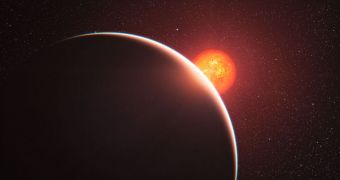A group of astronomers announces the discovery of metal elements in the atmosphere of an exoplanet identified only a couple of years ago. This is the first such object to have the chemical composition of its atmosphere modeled, and this is not the first interesting thing experts found.
Back in 2009, when experts with the Mearth Project first discovered the exoplanet, they cataloged it as a super-Earth, and called it GJ 1214b. This type of celestial body is similar to Earth in the sense that it's rocky, but its mass is several times that of our planet.
The team found the extrasolar planet orbiting the M dwarf star GJ 1214 in the constellation Ophiuchus, which is located right next to the constellation Serpens in the night sky. The exoplanet was determined to have a very tight orbit around its parent star.
Experts say that one year on GJ 1214b lasts for about 1.6 days. This close proximity to the M dwarf also means that the object is most likely tidally-locked, in the same way the Moon is locked to Earth, always showing the same face when viewed from our planet.
In 2010, this object became the first ever to have the chemical composition of its atmosphere analyzed, when experts looked at spectral readings collected via large telescopes. In that study, it was determined that the data indicated the presence of water vapors above the surface.
Intrigued by the findings, astronomers decided to investigate the matter further, and conducted the new research. This allowed them to decide between two models developed to explain why the planet's atmosphere has this peculiar composition.
The first was that the entire exoplanet was covered with the elements hydrogen and helium. However, this did not stand up to scrutiny, because spectral readings showed no signs of absorption for these chemicals, Universe Today reports.
In the second model, the planet contains a higher amount of metals, which is to say it has chemical elements that have atomic numbers higher than hydrogen and helium. According to the new study, more than 10 percent of the atmosphere is water vapor.
For those who are tempted to believe that this means the planet is inhabitable, think again. The close proximity to its star means that its surface is blistering hot, at around 535 degrees Fahrenheit (279 degrees Celsius).
Given the new knowledge about this alien world, astronomers have also proposed that it formed a lot farther away from its star than it is today. Its atmosphere may therefore have formed from sublimated ice, which would explain the water vapor.

 14 DAY TRIAL //
14 DAY TRIAL //